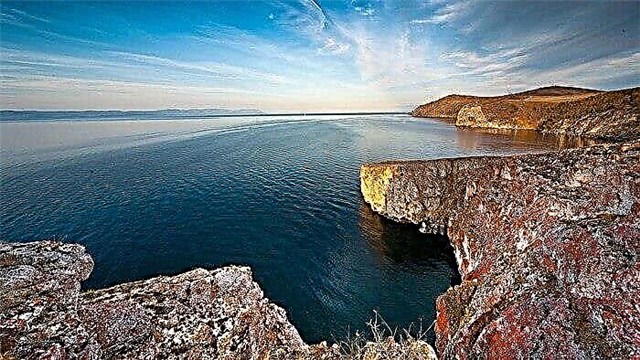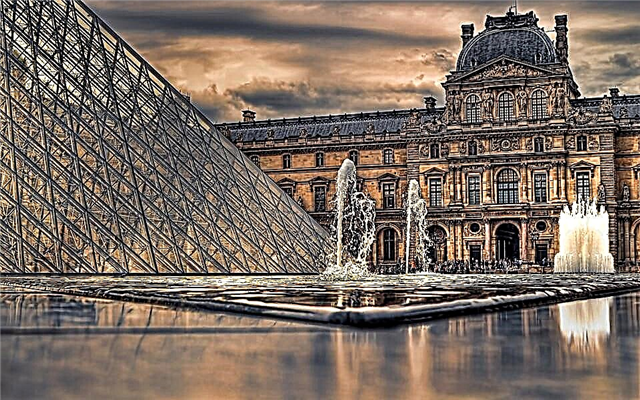Lake Baikal is called the "pearl of Russia", and this title is fully justified. They speak of him in excellent form: the purest, oldest, deepest. With its interesting puzzles, it attracts not only scientists, but also ufologists, esotericists and children.
Here are the top 10 brief but interesting facts about Lake Baikal or what the Buryats call it: Baigal Dalai.
10. This is the oldest lake in the world.
 With at least 25 million years of existence, Lake Baikal is the oldest lake in the world. It, like the surrounding mountains, was formed as a result of the destruction and movement of the earth's crust.
With at least 25 million years of existence, Lake Baikal is the oldest lake in the world. It, like the surrounding mountains, was formed as a result of the destruction and movement of the earth's crust.
Baikal was probably originally a riverbed, but tremors and cracks in the earth's crust increased its size and actually expanded the space between the banks.
Scientists believe that at first a series of lakes similar to the Great ones appeared, and then in the Pliocene era (from 5.3 to 2.58 million years ago) they united into one giant lake.
There are several theories about what might have caused such a union, including a meteorite fall, volcanic eruption, erosion, and earthquakes.
9. Baikal has a unique ecosystem
 Under the water surface of one of the most beautiful lakes in the world, active life is seething. The age, isolation and oxygenated water of Lake Baikal led to the creation of one of the richest freshwater ecosystems in the world. Interestingly, about 80 percent of the more than 3,700 species found on Lake Baikal are endemic. That is, they are not found anywhere else on Earth.
Under the water surface of one of the most beautiful lakes in the world, active life is seething. The age, isolation and oxygenated water of Lake Baikal led to the creation of one of the richest freshwater ecosystems in the world. Interestingly, about 80 percent of the more than 3,700 species found on Lake Baikal are endemic. That is, they are not found anywhere else on Earth.
Probably the most famous of these species is the Baikal seal, the only exclusively freshwater seal in the world. Scientists are not sure how the seal got onto Lake Baikal and evolved, but they suspect that seals could swim down the prehistoric river from the Arctic.
Other endemic species include oily fish, Golomyanka and Baikal omul.
In total, more than 50 species of fish live in Lake Baikal, and aquatic species of invertebrates include more than 100 species of flatworms, more than 700 species of anthropods (insects, arachnids and crustaceans) and more than 170 species of mollusks. These are scientifically confirmed facts.
8. Luminous balls are often seen over Baikal
 Locals and fishermen often reported unusual luminous balls appearing over the lake. Thanks to this phenomenon, Baikal has become one of the most popular destinations for mystical tourism.
Locals and fishermen often reported unusual luminous balls appearing over the lake. Thanks to this phenomenon, Baikal has become one of the most popular destinations for mystical tourism.
Locals believe that these balls are nothing but perfumes, and that it’s not safe near them. And the scientific community believes that the appearance of these spheres can be caused by spontaneous combustion of methane released from the lake. However, direct evidence of this theory has not yet been found.
7. Baikal - one of the seven underwater wonders of the world
 Curious fact: Lake Baikal was chosen by the CEDAM environmental group in 1990 as one of the seven underwater wonders of the world, along with:
Curious fact: Lake Baikal was chosen by the CEDAM environmental group in 1990 as one of the seven underwater wonders of the world, along with:
- Galapagos Islands.
- Republic of Palau in Micronesia.
- The coral reef of Ras Muhammad in the northern Red Sea.
- Belize Barrier Reef.
- Great Barrier Reef.
- Deep ocean fissures found in the Pacific, Atlantic and Indian oceans.
6. There may be gas or mud volcanoes at the bottom of Lake Baikal
 In Baikal’s photographs taken from space, dark circles are visible on the frozen ice surface of the lake during the winter months. These rings with a diameter of 5 to 7 kilometers did not change their location, but they did not appear every year.
In Baikal’s photographs taken from space, dark circles are visible on the frozen ice surface of the lake during the winter months. These rings with a diameter of 5 to 7 kilometers did not change their location, but they did not appear every year.
Scientists say that this is the result of the activity of gas or mud volcanoes located at the bottom of the lake. When these volcanoes erupt, warm gas rushes to the surface and underwater cyclones form.
These cyclones are warmer than water, and when the gas reaches the ice surface, these dark circles form. This theory of underwater cyclones caused by gas volcanoes is credible because the ice inside the circles has greater water saturation and is thinner than ice in other areas. In addition, scientists discovered microcracks on ice inside the circle, which indicates that the gas managed to pass through them.
And in 2015, scientists from Irkutsk State University found a mud volcano in the underwater part of the Selenga River Delta. He was given the name Telny, in honor of the nearest railway station.
Here is another interesting fact about Baikal: from the Buryat language, the word “Bai Gal” is translated as “standing fire”. Perhaps in ancient times people observed torches of burning methane on Lake Baikal.
5. Baikal - a natural source of fuel
 When deep-sea underwater vehicles explored the lake, they discovered gas hydrates - solid compounds made up of water and gas.
When deep-sea underwater vehicles explored the lake, they discovered gas hydrates - solid compounds made up of water and gas.
Interesting fact: heating 1 cubic meter of gas hydrate can produce 160-180 cubic meters of natural gas. For this reason, the scientific community views gas hydrates as future fuel resources.
At the moment, Baikal is the only freshwater lake in the world that has both direct and indirect evidence of the presence of gas hydrates.
4. Baikal - the cleanest lake in the world
 The stunning purity of Lake Baikal is the result of the purity of melted ice, the activity of microscopic crustaceans that feed on floating debris, and the lack of mineral salts and organic impurities in the lake. Under favorable conditions, you can consider objects located at a depth of 35 meters from the surface.
The stunning purity of Lake Baikal is the result of the purity of melted ice, the activity of microscopic crustaceans that feed on floating debris, and the lack of mineral salts and organic impurities in the lake. Under favorable conditions, you can consider objects located at a depth of 35 meters from the surface.
3. Only one river flows from Baikal
 It is interesting that more than 330 streams and rivers flow into Lake Baikal, but the Angara River is the only way out of the lake. At the source of the Angara stands a rock - Shaman-stone. According to legend, the hero Baikal threw him after his daughter Angara, who, against her father’s will, fled to the handsome Yenisei.
It is interesting that more than 330 streams and rivers flow into Lake Baikal, but the Angara River is the only way out of the lake. At the source of the Angara stands a rock - Shaman-stone. According to legend, the hero Baikal threw him after his daughter Angara, who, against her father’s will, fled to the handsome Yenisei.
2. Baigal Dalai - the sunniest lake in Russia
 If you decide to spend your vacation on Lake Baikal, then make the right choice. Indeed, for a year the number of sunny days is more than in the popular Russian resort - the Black Sea coast. For example, there are about 50 cloudy days on Olkhon Island per year.
If you decide to spend your vacation on Lake Baikal, then make the right choice. Indeed, for a year the number of sunny days is more than in the popular Russian resort - the Black Sea coast. For example, there are about 50 cloudy days on Olkhon Island per year.
1. Baikal can turn into an ocean
 Scientists put forward an interesting hypothesis that Lake Baikal is a gradually developing ocean. This hypothesis is based on the fact that the lake is located on the edge of the Siberian platform, and as tectonic plates move, the boundaries of the lake gradually expand - by 2 cm per year. This compares with the speed at which Africa and South America diverge.
Scientists put forward an interesting hypothesis that Lake Baikal is a gradually developing ocean. This hypothesis is based on the fact that the lake is located on the edge of the Siberian platform, and as tectonic plates move, the boundaries of the lake gradually expand - by 2 cm per year. This compares with the speed at which Africa and South America diverge.
Over time (in the very, very distant future), the lake can turn into an ocean.












